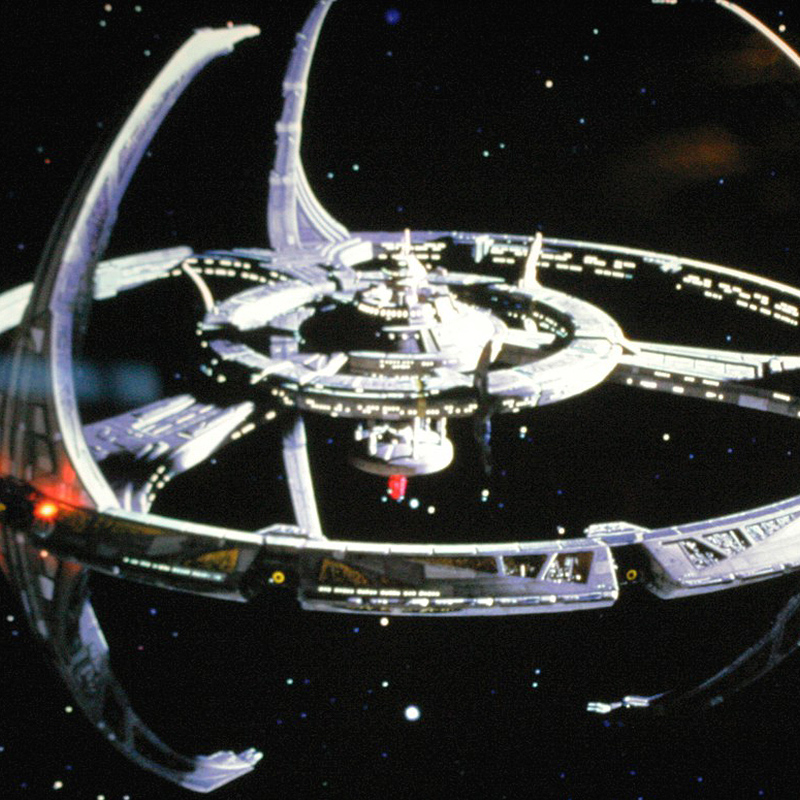Designing Deep Space Nine
Many of the elements Rick Berman and Michael Piller brought to Deep Space Nine had been established in Star Trek: The Next Generation. Bajorans, Cardassians, Ferengi and wormholes provided powerful strands of connection to the familiar universe first established by Gene Roddenberry and since enjoyed by millions of viewers. But the new series also demanded many unfamiliar things, ranging from an alien space station filled with ill-lit corridors, commerce, even a casino, to exotic new species and religious subtexts. It was a strange new world indeed that Star Trek explored boldly as ever.

On the technical side, Berman and Piller could tap into a pool of talented individuals who had worked on Star Trek: The Next Generation.
Production Designer Herman Zimmerman returned to design the dark and alien sets of the Cardassian space station. Michael Okuda led the Art Department’s effort to come up with an entirely new system of Cardassian control surfaces and data displays. Director of Photography Marvin Rush brought a rich lushness to the new sets. Costume Designer Robert Blackman refined the Starfleet uniforms and ably met the challenge of a never-ending stream of new alien species. Michael Westmore faced the same challenges in devising more and stranger alien races for Blackman to clothe. Visual effects that Star Trek fans had come to expect would be maintained and surpassed on the third series.
Designing the space station Deep Space Nine — which had to be a new, iconic and alien-looking image that could instantly be recognized when seen on a small television screen — was a long, arduous process that took several different directions before evolving into the final design we now take for granted. It was Zimmerman who had to come up with the fresh and unique look that would be the centerpiece of the new Star Trek.



Tower of Babel”
Early discussions about the look of the station led to a concept that would not work. “It took us a couple of months of going in the wrong direction to find the right direction,” Zimmerman told Star Trek: The Magazine in 1999, “partly because the producers weren’t sure exactly how they wanted to direct us with the visual elements.”
We started out charged with getting a “Tower of Babel” concept of a space station built over a couple thousand years of separate, disparate cultures, so the technology from one part of the station to another would be of various ages and various cultures, not necessarily interfacing one with the other, and there was this sense of confusion because of that.




“The initial take on it was that it was a very old, ancient type of station — maybe not symmetrical in shape,” Rick Sternbach, co-creator of the Deep Space Nine station, explained.
As Berman and Piller continued to refine the concept of Deep Space Nine, we [Sternbach, Okuda and Zimmerman] continued to evolve some of the exterior station drawings. We started with a very large number of sketches and very quick CGI shapes that we could build in our computers.
We could create a lot of shapes, make multiple copies of shapes and kind of put little pieces together and rotate them around and see how they would work. Also we could see if they would provide enough of a strange alien look that would be approved as Deep Space Nine.











Although the team came up with many possible concepts, Zimmerman explained that none were “slick enough or alien enough or unusual enough to satisfy Rick Berman’s desire for a show that would not compete with Star Trek: The Next Generation and would not be derivative of any existing features of The Original Series.”



When we finally arrived at the concept we have now, it was because Berman said, “Forget about the Tower of Babel, forget about the various cultures; give me the most alien thing that you can create that could be a space station at the edge of the galaxy.” I think we succeeded in doing that.








Recognizable shape
Berman still wanted a recognizable design. Sternbach remembered that his desire for a simple shape led the team back to one particular concept:
We went back to something Herman had offered up initially, which was a series of nested sort of hoop structures, or ring structures, and went back to that concept of a round wheel type of station.
This new direction incorporated three separate ideas.
I thought of a gyroscope shape as maybe being a basic form that we could with with. We also vaguely connected the gyroscope shape with the shape of an atom, with all the electons running around the nucleus. So what you see in the Deep Space Nine exterior now is a combination of an atom, a Mercedes emblem and a gyroscope.






Building the miniature
Now Zimmerman and the production team had to get the station built in time. “There was some haste necessary, because we had used up two of our three months of pre-production going in the wrong direction, so when we got the right direction we had precious little time left to make it all work.”
Sternbach added that by then, all the details had been worked out pretty much accurately and the design changed only subtly:
When the blueprints were delivered, there were very few changes. All the major story point pieces on the station had been detailed out and approved and built into the station.
Once the 6-foot miniature had been constructed and photographed, it would remain the focal point of the series for the next seven years.

2 comments
Submit comments by email.